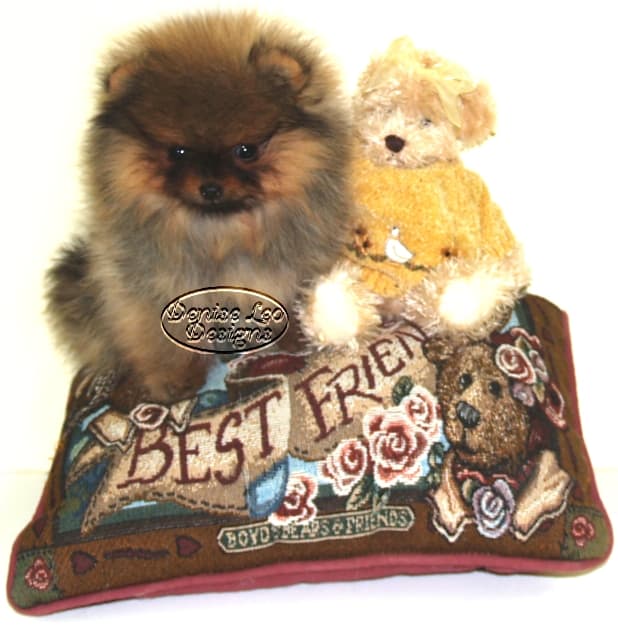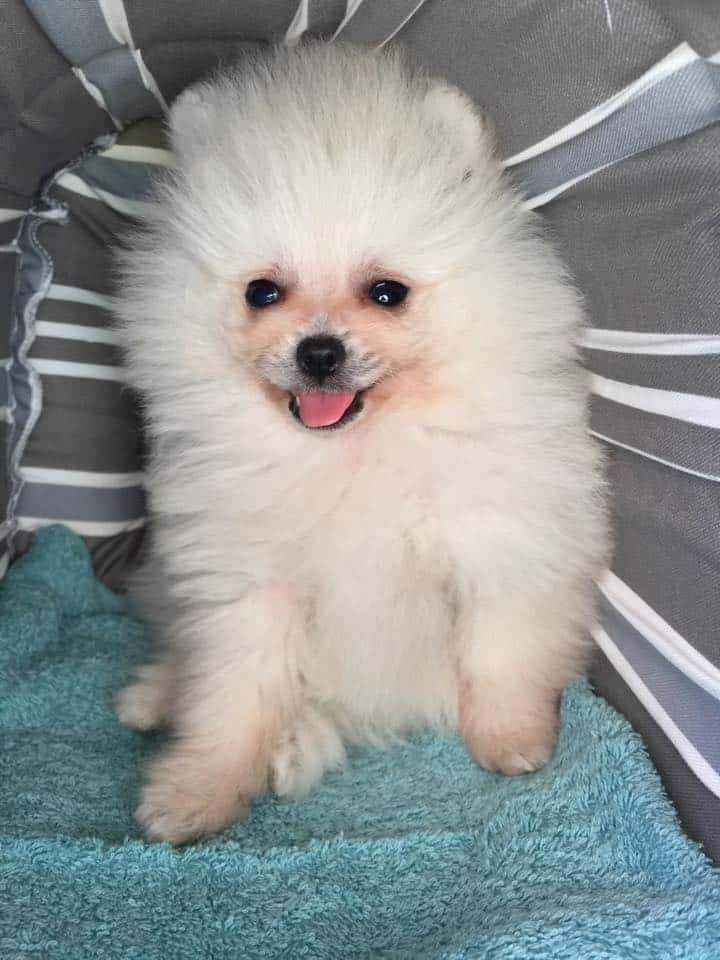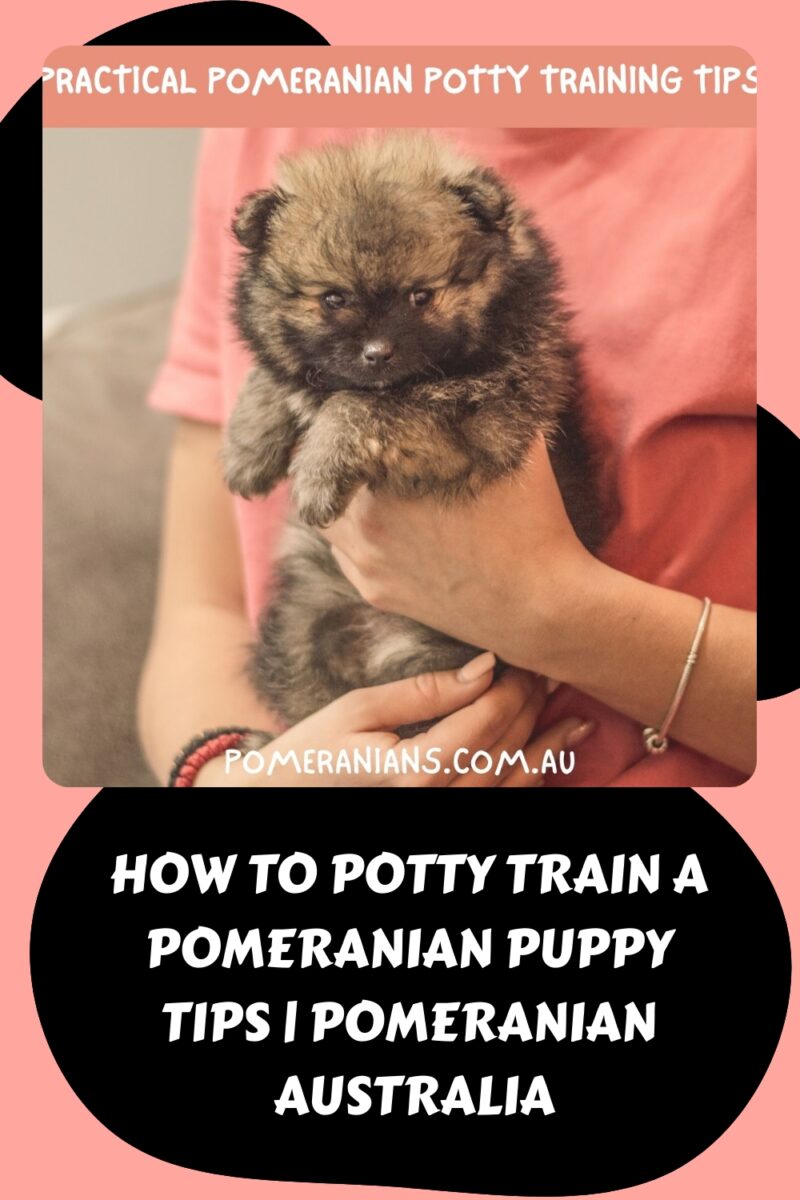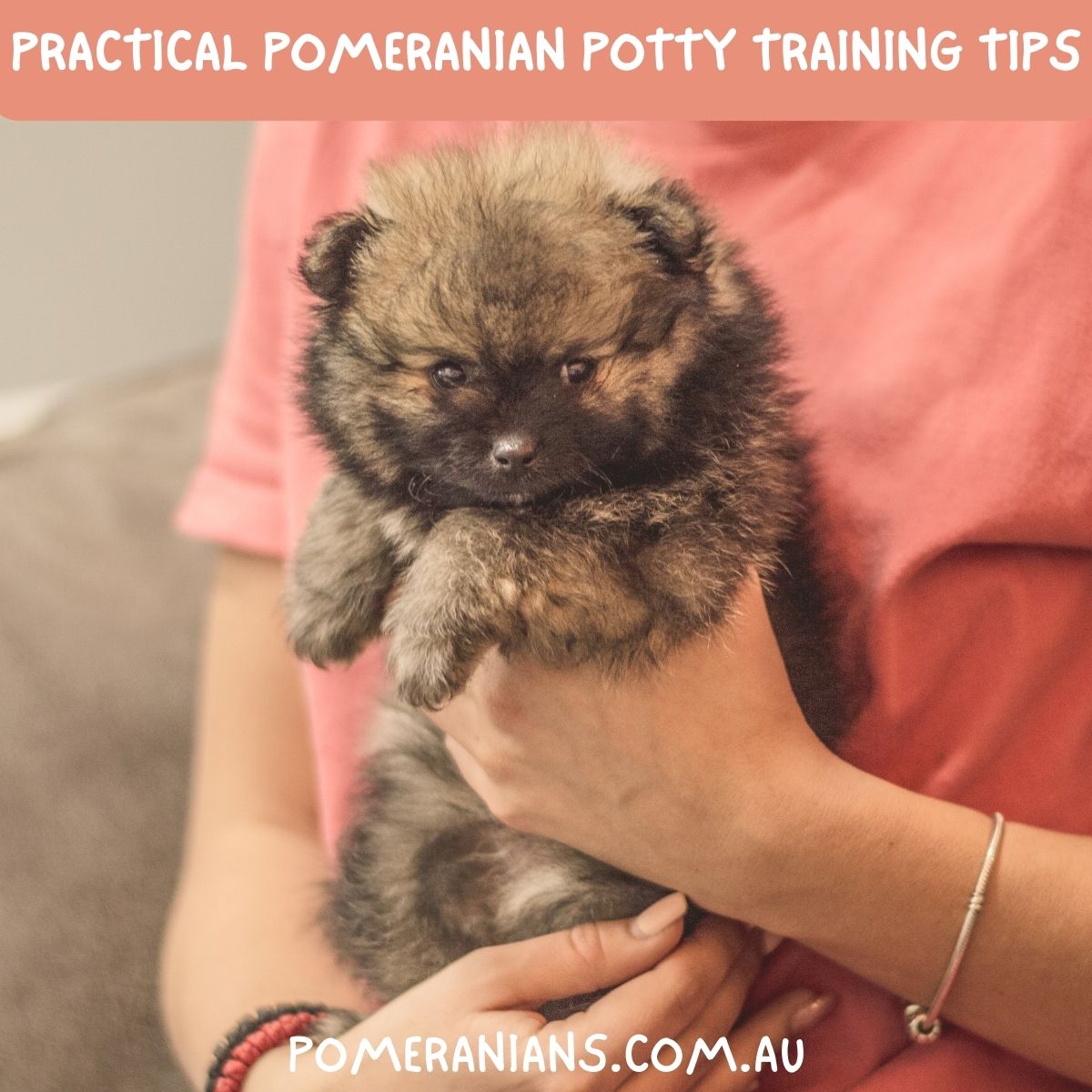Last Updated on April 15, 2024 by Denise Leo
After receiving numerous emails asking for help with house training a Pomeranian, I decided there was a need for Pomeranian training tips.
Establishing house rules, such as toilet training for your Pomeranian puppy, is crucial for fostering a positive relationship between the puppy and its human family.
Pomeranian puppy owners often ask how to potty train a Pomeranian!
Denise Leo, a Pomeranian expert, is here to guide one of the most common queries from Pomeranian puppy owners: how to potty train a Pomeranian!
Denise suggests: Consistency, patience, and positive reinforcement are key to successful potty training. Start by introducing your puppy to a designated potty area where you place pee pads or a litter tray. Consistently take your puppy to this area, especially after meals, naps, and playtime.
Using a consistent cue word each time they go to the bathroom helps them associate the word with the action. Reward your puppy with lot of praise and a treat immediately after they finish doing their business in the correct spot. This positive reinforcement makes them more likely to repeat the behavior.
Maintaining a regular feeding schedule is important to predict when your puppy will need to go. Accidents are a normal part of the learning process, so never punish your puppy; gently redirect them to the right spot. Over time, with persistent training and plenty of love, your Pomeranian will learn where it’s appropriate to satisfy their bathroom needs.
Denise Leo, Dochlaggie Pomeranians, Australia.

How to House Train a Pomeranian
Puppies need a place where they feel comfortable, safe, and secure. This is a vital part of Pomeranian training and house training a Pomeranian.
A dog is a creature of habit. He likes to go to the toilet in the same places he has been before. It would be best to control where he goes so he doesn’t make a mess of your nice carpet or expensive lounge suite.
When unsupervised, your new puppy should have restricted access to your home until completely housetrained. He should be confined in a puppy playpen with clean newspaper down at one end and food, water, and a comfortable bed at the other end.
Puppy sleeps in this area, and I leave him safely confined to the playpen when I go out.
An Important Part of Pomeranian Potty training is:
- As soon as the puppy wakes up, I take him outside to the area I want him to use as a potty area. I also take my puppy to this area after meals, and when he has done his business, I reward him with heaps of cuddles and tell him how good he is.
- After the puppy has been to the toilet, let him run around your house. Remember, as he’s new to your home environment, it will take him a while to get used to the house, where he can go, what interests him, and so on. Assuming you have doggie doors, he’ll also have to learn where they are, so eventually, he’ll use them and go out when he needs to.
- Watch carefully for any indications that your puppy needs to go outside to the potty area. Indications usually include circling and smelling, looking for an area to use as a potty area, and then squatting. This takes a lot of patience and persistence. Doing this correctly during the first few weeks will pay off in the long term.
- Accidents do and will happen. Young puppies have very small bladders and cannot “hold on” for hours, so I don’t like crate training for young Pomeranian puppies.
- Usually, a puppy can go for the same amount of hours as his age in months. Expect a two-month-old puppy to require a toilet break every two hours, and a four-month-old puppy will need a visit to the potty place every four hours.
- If you catch your puppy “in the act,” grab and take him outside quickly. Then, tell him “potty” or whatever trigger word you choose. If he does more, reward him for it.
- Don’t smack the puppy or attempt to rub his nose in his accident.
- Immediately take the puppy to the potty area. Clean up the accident immediately and ensure no lingering smells, or the puppy will use this area repeatedly.
- Your behaviour must be consistent. It’s no good yelling at your puppy if he makes a mess because that will only scare him.
Like most dogs, Pomeranians are generally very intelligent. However, they don’t understand the correlation between urinating or defecating where they shouldn’t and you yelling at them or rubbing their nose in it.
This is especially true when they have left the “crime scene,” and you find it later and then go crazy. So, it’s not the right way to successfully housetrain your puppy.
If the puppy has been using a rug or newspaper, you can place either item in the area you want the baby to use as the potty area. The smell will help the puppy associate this area with going to the toilet.
Your Pomeranian puppy will most likely want to potty when he wakes up in the morning, after a nap, before eating, and before bed. One way to train him to go outside is to wake him in the morning and carry him outside. If he feels grass on his paws, he will associate that with the urge to potty and, with some luck, not want to go on your carpet instead.
You can use white vinegar when you want to clean an area where the puppy has made a mess. It’s an excellent cleaner and safe on most carpets. It’s also good for eliminating puppy odours so the puppy won’t feel the urge to potty in the same spot again.

Toilet training your Pomeranian can be challenging yet rewarding, and establishing good habits from the start is essential. For new pet owners, using puppy pads can be the most effective way to teach your Pom puppy where the right spot is for their bathroom needs. These pads are especially useful for small dogs like Pomeranians, who have tiny bladders and may need frequent potty breaks.
Starting the training process at a young age is a good idea, as this sets the foundation for good behavior later. Consistent training and routine, including a consistent feeding schedule, are crucial. Place the pee pad in a designated area of your living space to help your canine companion understand the location for elimination. This area should be small to avoid confusion and help your furry friend learn to control their bowel muscles.
Positive reinforcement plays a key role in successful toilet training. Every time your Pom uses the pee pad in the right place, reward them with praise and a small treat.
This encourages the puppy to repeat the desired behavior and makes the training a positive experience for both of you. Additionally, using a cue word or verbal cues can help your dog associate the act of elimination with a specific command, making understanding what is expected over time easier.
For adult Pomeranians or older dogs, you might have difficulty breaking any bad habits they’ve already developed. However, consistent training with lots of praise and the right approach can teach an old Pomeranian new tricks.
For adult dogs, especially those indoors for long periods, litter trays or litter boxes could be a good alternative, offering a permanent and easily accessible potty spot.
It’s important to address accidents with the right attitude and avoid punishment, which can lead to fear and confusion. Instead, use an enzymatic cleaner to remove odors effectively, minimizing the risk of subsequent accidents in the same spot. If you’re finding it particularly challenging, consulting a professional dog trainer may provide additional strategies and support tailored to your Pomeranian’s age and unique needs.
Proper training, consistent schedule, and positive reinforcement are the most important factors in successfully toileting your Pomeranian. With patience and consistency, your Pom will learn where the right place is to meet its bathroom needs, ensuring a happy and hygienic environment for your best friend and your home.
Litter Training Your Pomeranian Pup
Starting this is easiest when your Pomeranian puppy is three weeks old. I place a very low tray of cat litter at the entrance to his bed. The first thing the Pomeranian puppy steps onto when getting out of bed is the kitty litter tray. As the puppy gets older, I move the litter tray further away.
Litter training your Pomeranian is a smart alternative to puppy pads or outdoor potty training. This method can be particularly effective if you live in an apartment or lack easy access to an outdoor space. Litter trays for dogs, similar to those used for cats, can be filled with commercial cat litter. Here are some additional tips and insights to help you effectively litter train your Pomeranian, offering you and your pet a convenient and hygienic solution:
- Start with the Right Litter Box: For Pomeranians, selecting a litter box with the right size is crucial. It should be large enough for them to turn around but not so high that they need help getting in and out. This is the first step towards successful litter training.
- Place It in an Appropriate Area: The litter box should be placed in a quiet, low-traffic area of your home. Ensure it is away from their feeding area and not too close to where they sleep. Consistency in location helps your Pomeranian understand where it’s appropriate to go.
- Introduce Your Pomeranian to the Litter Box: Gently place your Pomeranian in the litter box after meals, upon waking, and after play sessions. These are the times they are most likely to need to go. Use consistent commands like “go potty” to help them make the association.
- Reward Success: Every time your Pomeranian uses the litter box correctly, reward it immediately with praise and a treat. This positive reinforcement will make it more likely to use the box again.
- Keep It Clean: Regular cleaning is crucial for your Pomeranian, especially when using its litter box. Dogs, like cats, prefer a clean place to relieve themselves. Scoop the litter daily and change it regularly to manage the odor and maintain hygiene.
- Be Patient and Consistent: Litter training requires patience and consistency like any other training. Some Pomeranians may take to it quickly, while others may need more time to adjust. Stay consistent with your commands and rewards, and keep the litter box clean and inviting.
Litter training offers a convenient and hygienic solution for managing your Pomeranian’s bathroom needs, especially if you’re often away from home for many hours. With time and training, your Pomeranian can learn to use their litter box reliably, making it a practical choice for you and your pet.
Final Thoughts on Pomeranian Toilet Training
Embarking on pomeranian potty training can be challenging, but take heart: success is well within reach with the right training methods and a consistent routine. For owners of small breeds like Pomeranians, understanding the most important factor in potty training—consistency—is crucial.
This includes scheduling regular potty times, using potty pads in a designated bathroom area, and monitoring your Pomeranian puppy, especially during the early stages of training.
While some may have a hard time initially, remember that your patience is the key. Give your Pomeranian enough time to adapt to their new routines. Simple solutions such as using a baby gate can help manage their space and prevent accidents. It’s also important to keep the potty area clean to control odors and maintain hygiene, using products like odor-control paper towels for quick cleanups.
Remember, every dog’s age and health status can affect its training progress, so it’s good to schedule regular vet visits to rule out any medical issues that might hinder its learning. As your Pomeranian grows and continues to learn, aim to develop it into a canine good citizen who can confidently manage its needs in indoor and outdoor spaces.
To all dog owners, remember that the simplest way to achieve potty training success is through dedication, correct techniques, and lots of love. Keep these tips in mind, and you’re well on your way to having a well-trained Pomeranian who is both a joy and a source of pride.
Here’s to many successful housebreaking lessons ahead—your efforts now will pave the way for a harmonious living space with your furry friend.
© Copyright Pomeranians Australia. All Rights Reserved. This Article is not to be reproduced in any form without the author’s written permission.
References and Further Reading:
Official Standard of the Pomeranian (AKC). American Kennel Club, 2011.
English Kennel Club Pomeranian Breed Standard, 2017.
Denise Leo, The Pomeranian Handbook.



